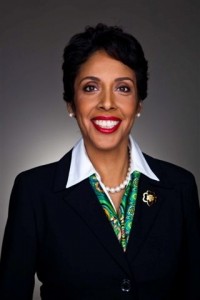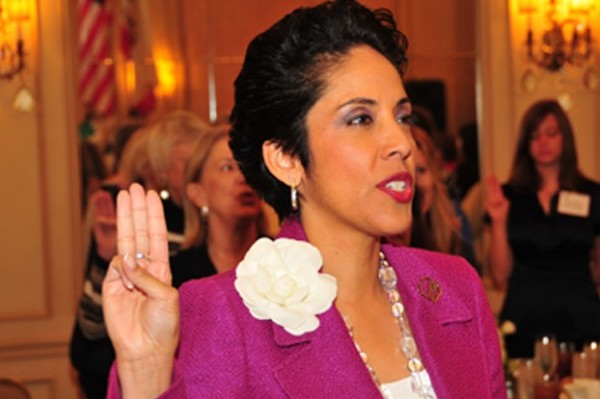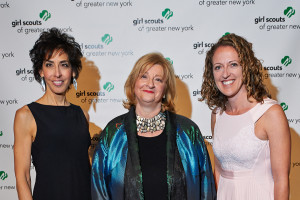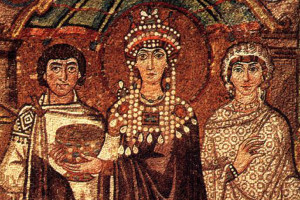Anna Maria Chávez, CEO of Girl Scouts of the USA, Tells Us How the Organization Strengthens Young Women Across the Country
“When you invest your time, energy or resources into a girl, she can change the world.” –Anna Maria Chávez, CEO of Girl Scouts of the USA
More than half the women in America can claim to have been members of Girl Scouts as young girls: they recall Brownie beanies, “Worlds to Explore,” campfire songs, s’mores and selling cookies. Many of them grew up to become the leaders of major corporations and organizations across the globe. CEO of Girl Scouts of the USA, Anna Maria Chávez, a Girl Scout herself in her youth, sees both the rich history and the road yet untraveled for the organization.
 Her eyes on uncharted territory just might have been one of the things that prompted Chávez to quickly join forces with Sheryl Sandberg, COO of Facebook and author of the book “Lean In,” for the new campaign “Ban Bossy” an effort to wipe the word ‘bossy’ from vernacular, at least as it pertains to girls and leadership, that launched yesterday. “Girls are twice as likely as boys to avoid leadership roles for fear of being deemed ‘bossy’ by their peers,” explains Anna Maria Chávez, CEO of Girl Scouts of the USA (GSUSA). “At Girl Scouts, we want to bring adults and girls together to empower them as our next generation of leaders.”
Her eyes on uncharted territory just might have been one of the things that prompted Chávez to quickly join forces with Sheryl Sandberg, COO of Facebook and author of the book “Lean In,” for the new campaign “Ban Bossy” an effort to wipe the word ‘bossy’ from vernacular, at least as it pertains to girls and leadership, that launched yesterday. “Girls are twice as likely as boys to avoid leadership roles for fear of being deemed ‘bossy’ by their peers,” explains Anna Maria Chávez, CEO of Girl Scouts of the USA (GSUSA). “At Girl Scouts, we want to bring adults and girls together to empower them as our next generation of leaders.”
Empowering girls to become leaders is not new; the Girl Scouts have been doing it for 102 years. What are new are the pathways, innovative programs, and opportunities for girls and adults to interact that are widening the road to success for coming generations of girls. I asked Anna Maria Chávez about her role as CEO, what advice she would offer women in executive roles, and what the changing face of Girl Scouts looks like today.
Ms. Chavez, what do you see as the most important thing(s) Girl Scouting offers to young women?
Courage, confidence and character – instilling those qualities in girls has been the mission of Girl Scouts since the day we were founded, and nothing has changed in the ensuing 102 years.
Girl Scouts offers girls a chance to learn and grow in an environment that is girl-centered and girl led; providing a supportive, comfortable, safe space for girls to discover their talents and abilities, to try new things, and feel free to just be a girl, all while learning the skills to make them leaders in their own lives.
Girl Scouts has invested in some significant research in recent years to learn how to better reach and serve their target audience, leading to a better understanding of what girls want and need to know to grow strong. Can you tell me what GSUSA learned about girls?
In December 2013, we released a report called The State of girls: Unfinished Business through our Girl Scouts Research Institute. What we found was fascinating.
One of the major takeaways was that the face of the American girl is changing, and that change is taking place even faster than many people realized or expected. In 2000, 62 percent of all girls ages 5 to 17 were white. By 2010, that proportion had decreased to 54 percent, and it is projected to continue to decrease to 47 percent by 2030. Meanwhile, the Hispanic/Latina girl population has grown steadily. In 2000, 16 percent of the girl population ages 5 to 17 was Hispanic/Latina. In 2010, that proportion had grown to 22 percent and is projected to reach 31 percent in 2030. The current white majority is expected to be less than half of all girls (47 percent) by 2030.
These changing demographics are affecting everything, and the fact is right now, Black/African American and Hispanic/Latina girls are far more likely than their white counterparts to face an array of socioeconomic hurdles that range from growing up in poverty or a low-income household to dropping out of school and struggling with obesity.
These findings should be a wakeup call for all of us. We can’t afford to have separate experiences for girls based on race, ethnicity, and social class. For over one hundred years, Girl Scouts has been there for all girls, and we are now more committed than ever to lifting up any girl that is falling behind. There is a new emerging majority in this country, and Girl Scouts is set to take the lead in ensuring that all girls have equal opportunities.
What does the Girl Scout program look like now? How has it evolved?
One of the biggest challenges any century old organization will face is keeping their program modern, fresh, exciting, and relevant for today’s customers. Our customers are girls, and our motto is that we have to move at the “speed of girl.” That means adapting to the ever-changing pace of modern life, and ensuring that we are offering programs that girls find exciting and innovative, while being important and relevant to the modern world.
Over the past several years, we have revolutionized our programs in order to bring Girl Scouting fully into the 21st century. Today’s Girl Scouts participate in programs that range from video game design and robotics competitions, to financial literacy and money management.
Our programs are designed not only to teach girls how to lead, but to lead in the industries of tomorrow. Our Naturalist badges invite girls to explore the outdoors. As girls learn to love nature, they’re inspired to protect the environment.
As girls earn their Innovation badges, they solve problems by using methods from many fields such as anthropology, engineering, graphic design, and business. We offer badges in fields like STEM and digital arts that connect girls to science topics they love — from the development of video games to the physics of roller coasters to the technology used to create new fabrics.
And of course, our world famous cookie program teaches girls vital skills in business and entrepreneurialism they wouldn’t get anywhere else. Financial Literacy badges prepare girls for a sound financial future. Girls learn how to save, spend, and give to others.
What advice can you offer to our readers—executive and professional women—on how to raise their own daughters to be better decision makers and influential adult women?
I think one of the most important things that any young person can do is to find a reliable mentor – someone who has blazed the trail they want to follow; someone who they can trust implicitly, and is willing to serve as a sounding board and a guidepost.
Girls also need to be encouraged. The number of ways we discourage girls, both passive and active, from taking leadership roles in school or even in families is astounding. Champion a girl’s ambitions; encourage her to learn and try new things, and be there for her when she falls. When you take your daughter shopping, let her make change and pay at the register. Take her to the bank; teach her how to fill out a check. Nurturing a girl’s natural desire to learn is so important to the person she will become.
For girls themselves, I say this: Don’t be afraid to fail. I see this so often and perhaps it’s part of how we are wired as human beings. In many ways, we learn so much more from failures than our successes. Take the view that failure is nothing more than a means to an end. The world is filled with great quotes about the virtues of failure. The founder of Girl Scouts, Juliette Gordon Low, searched throughout much of her life for something that would give it meaning and dimension. It wasn’t until she was in her 50s that she came across the nascent idea of Girl Scouting and she threw herself at the task with incredible energy and enthusiasm. And she changed the world. She is such an inspiration to me and to millions of Girl Scouts. If you’re not afraid of failure and have the passion and enthusiasm for the task at hand, self-confidence will take care of itself.
Who are some of the more successful or famous former Girl Scouts? What traits do they share that they might have acquired in Girl Scouting?
We are so proud of the fact that so many of today’s most successful women, from Washington to Wall Street and beyond, are Girl Scout alumnae. We have over 59 million living Girl Scout alumnae in America today; meaning roughly 50% of American women have worn our sash at some point in their lives.
What we know is 70% of the female CEOs on the Fortune 500 list are Girl Scout Alumnae. We know better than 50% of the women serving in Congress are Girl Scout Alumnae. The last three female Secretaries of State are Girl Scout alumnae. I truly believe that the first female president, whomever she may be from whatever party she may belong to, will be a Girl Scout Alumnae.
Girl Scouts taught these women basic business skills through our Girl Scout cookie program; Girl Scouts taught them to be leaders and to be fearless. But more importantly, it gave them the courage, confidence and character to make their world a better place.
According to GSUSA, you cut your teeth in volunteering as a girl in Girl Scouting and continued a passion for service throughout your adult life. Serving an organization and becoming its CEO must be very different in scope. In what ways is the role of a CEO at a not-for-profit different from the role of other CEOs?
I cut my teeth as an actual Girl Scout! When I was 10 years old, my best friend joined Girl Scouts, so I decided I wanted to as well – and no question that it lit a fire for serving others and helping the world that has stayed with me to this day. These values were instilled in me during my time as a Girl Scout, and as part of my upbringing in a close-knit Latin American family.
These values propelled me to a career in law, federal government, and state government in Arizona. When I had an opportunity to come full circle and return to the Girl Scout Movement, I jumped at the chance. I am proud to lead this Movement, and proud to be instilling those same values in today’s girls.
At the end of the day, I don’t think being the CEO of a for-profit is all that different from a nonprofit. It’s simply a difference in your product. At a nonprofit, you’re delivering an experience, something fundamentally intangible, but that has the power to change lives forever and for better. Nonprofits are about mission delivery, and having the vision to ensure that mission is upheld.
In the three years you have been CEO of GSUSA, what have been the greatest challenges for you?
I don’t tend to look at challenges as obstacles in my way. Certainly, as a 100-year-old organization, we face the challenge of trying to stay relevant, fun and engaging for girls as their world and their lives change so rapidly. But I tend to be a very proactive and positive person and rather determined and so when I have a goal, I focus on achieving it. It’s how I’ve always lived my life.
Did you anticipate those challenges or has the position as CEO been different or held different challenges than you thought?
I wouldn’t say anything has been a huge surprise. Obviously when you are the CEO of the National Organization, you face a different set of challenges, problems and goals than when you lead a local council, but I think you know when you take on any new challenge that there are going to be obstacles. The key is to see opportunity in the process, and approach each situation with courage, an open mind, and empathy.
If your role has been different from what you imagined, what advice would you offer women when, and if, their new executive position does not measure up to what they had invisioned?
Again, challenges will always arise. I try not to set expectations for any given situation, and to not dwell too much on the past. As my grandmother taught me, “stay on your track.” She believed we all have a destiny, a track in life, and even when things aren’t perfect, if you keep your eyes on your track, work hard, and do what you believe is right, life has a funny way of helping you reach your destination.
There seems to be a constant flow of negative press regarding Girl Scouting’s position on issues from abortion to homosexuality. What is the official position of GSUSA with regard to those issues?
Girl Scouts is a non-partisan, non-political organization. We don’t take positions on social issues, so we have no official position with regard to any of the issues you name. We believe these are deeply personal and private matters, best left to families to discuss with their daughters. We find it unfortunate that some groups would seek to use our Movement to advance a political agenda, but our mission is and has always been, focused on giving girls the skills they need to lead in their own lives. It’s not a political mission. We’re all about the girls.
Since negative press is an issue for many businesses, not just not-for-profits, how do you address those questions or issues? How should a CEO, an executive or organization respond to issues that do not tell the entire story or sckew people’s view of a business or organization?
There’s an axiom that states that when it doubt, you should just go with the truth, if only because it’s the easiest thing to remember. The bottom line is that feedback is a gift and criticism is a part of life. To lead a major organization you have to be prepared to deal with some blowback. When lies or mistruths are spoken about your organization, all you can or should do is simply broadcast the truth and ensure everyone knows the full story. There are some for whom it will fall on deaf ears. But you can’t be worried about them; what’s important is that your customers, constituents, and the majority of reasonable people know and understand the truth.
What is GSUSA doing to recruit an increasingly diverse membership?
Our Movement has been committed to diversity since our founding over 100 years ago. We have a very active outreach to minority groups across the United States. As the face of America changes, the face of Girl Scouts needs to change too. Some of our most active councils and highest growth rates have come from the Latina population, and our Hispanic Initiative aims to deliver high-quality programs to every Latina who wants to be a Girl Scout. We want Girl Scouts to reflect the face of the United States. By increasing the visibility of Girl Scouts in minority communities and actively working to engage and recruit adults from within those communities, we are working to expand the reach of Girl Scouting so that more girls than ever before can benefit from our program.
How can women in business assist in promoting those goals?
If they’re alum (and chances are that they are) they can start by coming home to Girl Scouts. Volunteering for our organization, as a troop leader, cookie mom, or as a mentor and guide for girls, is the best way to give back and help us deliver on our Mission for the next generation of girls.
Latina’s and other women of color who have succeeded in business also have an important role to play in serving as mentors and role models. Make yourself available to girls, encourage their ambitions, and be willing to answer their questions and guide them down the path you blazed.
Would you like to address the ways in which women can help Girl Scouts as an organization to grow stronger and to continue the legacy left to us by our founder so that Girl Scouts will be around for another century?
At Girl Scouts, we have a campaign called “To Get Her There” a social movement designed to bring about gender-balanced leadership in the American economy in just a single generation.
Through “To Get Her There,” we are enlisting the support of every member of society – women who can serve as role models, mentors, and volunteers, but also fathers, brothers and sisters, friends and mentors alike – to be there for a girl in their lives.
It is so vitally important, because we know that when you invest your time, energy or resources into a girl, she can change the world. We also know that, more and more, the pressures of a truly global economy are requiring us to leverage the full economic potential of both men and women in the work force. “To Get Her There” is about recognizing the need for change in our society – the transformations driving our current economic realities are bigger than anyone could have imagined a decade ago.
It’s amazing what you can do for a girl by just being there in her life. Encouragement, support and guidance are the keys to ensuring a girl’s success. That’s what “To Get Her There” is all about.
Obviously, the foundation of the Girl Scout organization is adult volunteers, Chávez said, “… we are always looking for wonderful new additions to our group of dynamic adult volunteers. Being in the field and having a direct impact on these girls is such a fun and rewarding experience.”
Readers who wish to celebrate Girl Scout Birthday with a contribution to Girl Scouts of the USA or who would like more information on giving can visit: https://www.girlscouts.org/support
Photos: Girl Scouts
TAGS: Girl Scouts leadership WiB
 Interviewer Interview Prep
Interviewer Interview Prep Impactful Mentees
Impactful Mentees Benefits of a Mentor
Benefits of a Mentor Advice for First-Time Managers
Advice for First-Time Managers Overcoming the 18-month Itch
Overcoming the 18-month Itch Dressing for Your Style
Dressing for Your Style Interview Style Tips
Interview Style Tips Women's Stocking Stuffers
Women's Stocking Stuffers Gift the Busy Traveler
Gift the Busy Traveler Father’s Day Gift Guide
Father’s Day Gift Guide Airport Layover Activities
Airport Layover Activities Traveling & Eating Healthy
Traveling & Eating Healthy Travel Like a Boss Lady
Travel Like a Boss Lady The Dual California Life
The Dual California Life Gifts for Thanksgiving
Gifts for Thanksgiving Summer Reading List
Summer Reading List Top Leisurely Reads
Top Leisurely Reads New Year, New Books
New Year, New Books Life Lessons from a Sitcom
Life Lessons from a Sitcom Oprah, Amy or Amal?
Oprah, Amy or Amal?














